Open Banking will change the Financial Services Industry forever
Banking sector always enjoys a monopoly of other financial services. With the introduction of digitalization the sector has gone through some rapid changes. Open Banking essentially creates an ecosystem of data sharing which could revolutionize the banking industry. Open Banking has been embraced by many countries in Europe, with the European Union already supporting regulation through the Revised Payment Services Directive (PSD2) in January 2018. PSD2 will be a turning point for banking as the EU countries are obliged to incorporate PSD2 into national law and force banks to publish their Application Programming Interfaces (APIs). More importantly, Open Banking gives equal position to services from banks and fintech firms and will set the benchmark for the rest of the industry globally. Indeed many banks and credit unions have already begun to invest in Open Banking technology, including CO-OP. MicroMoney is also following the trend.

The main goal of PSD2 is to ensure maximum transparency and security, encouraging competition in the financial industry. As a result, the quality of financial services will improve, and fees will decrease. Consumers’ financial data will be released from the bank’s monopoly and will finally become the property of the customers who will have open access to it at will.
Following are some of the main benefits that Open Banking hopes to deliver to consumers and the industry at large.
1. Faster Payments
Open Banking will enable payments to become almost instantaneous, as Payment Initiation Service Providers (PISP) — firms that initiate payment transactions using bank API connections — will be able to integrate all payments into one digital interface. This means paying bills, paying for goods or transferring money can be as fast as sending a text message.
2. Enhanced Security with Third-Party Services
The release of users’ data to third-parties is technically in violation of the agreements with banks and their customers currently but Open Banking has the ability to change that. With approved access to bank APIs, developers of third-party applications no longer have to rely on the risky practice of “screen-scraping” and will likely be required to license their operations with regulators, as well as meet a host of other security standards.
3. A More Seamless Experience
As Open Banking and artificial intelligence (AI) converge, the user experience will be digitally transformed. Data will stream in from a multitude of sources, allowing service providers to hone in on exactly what a consumer needs at any given time. In essence, banks and other financial institutions will be able to create a profile of each customer, forecast their patterns and behavior, and build customized products more efficiently. Users will also be able to enjoy faster onboarding as they’ll no longer be required to provide authentication across multiple providers.
4. Increased Competition
With so many barriers to entry broken down, we can expect market competition to increase dramatically — and this will open up a new landscape of products and services available to consumers.
5. Open Banking Brings Financial Freedom to Customers
Open Banking will cause the rapid growth of financial services, taking the user experience to the next level. Many procedures will become simple and automated. With access to the banking APIs, fintech firms can provide users with opportunities to improve their financial lives. For banks and fintech companies, this means only one thing. It is necessary to revise the existing user flow and redesign the actual service to eliminate friction, making it valuable for customers.
Currently, banks have an infrastructure and a customer base, but they are burdened by a product-centered thinking legacy. Most banking solutions are outdated, and interfaces are not intuitive. Unlike the banks, fintech companies create modern, client-centered solutions, but they do not have enough resources to bring them to market and acquire customers. The API will provide third-party developers with access to banking systems and customer databases, thus allowing end users to manage bank accounts via third-party service interfaces that do not belong to their primary bank.
New technology if shifting the center of gravity for traditional core banking systems. A blockchain-based approach to core banking could act as a catalyst to fracture the monolithic and vertically integrated approach to core banking. A modular approach to lending, syndication, capital markets could utilize blockchain to tie it all together. All the other elements of transactions management, the integrity of transactions, messaging, etc are inherent features of blockchain. When machines are able to perform transactions with machines in real-time at a marginal cost basis, the concept of payments will become obsolete in many use cases as transactions become automated and integrated into other platforms and services. These trends all sum up to the inevitability of open banking or banking as a platform.
However, open banking should be perceived as more than just a technical implementation. For banks to embrace open banking, incumbents need to also challenge internal culture and existing business models. In addition to banks such as Spanish bank BBVA, Capital One, ABN Amro and Nordea other financial services such as MicroMoney is also joining the open banking revolution. While open banking may not be the silver bullet for reinventing banking industry, it represents a catalyst for change.